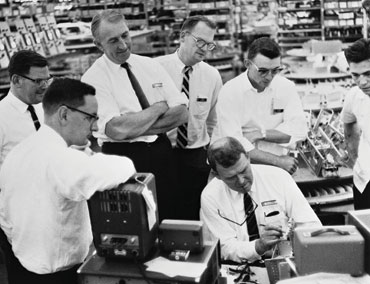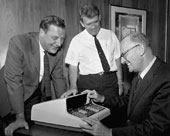|

By Jamie Beckett, Feb. 2006
When Bill Hewlett and Dave Packard decided to establish a central research lab in 1966, they hoped that researchers freed from day-to-day problems could more clearly focus on ideas that would help shape the company's future. Scientists in the newly hatched HP Labs wasted no time in proving them right. One of their earliest innovations was the world's first desktop scientific calculator, not only provided unprecedented computing power for it size, but it launched HP into a whole new business.
It also set the tone for four decades of innovation at HP Labs. Whether engineers are exploring new computing architectures, color printing technologies or quantum computing, their sites remain set on one goal: making a contribution. That's why the lab chose "Innovation that counts" as the theme of its 40th anniversary celebration.
"We rarely work on technology for technology's sake," says Dick Lampman, senior vice president for research, HP, and director of HP Labs. "What we focus on is where these technologies will make a difference, what customer will value it and how HP can build a business around our innovations."
No ceremonies or speeches marked the creation of HP Labs. R&D had always been central to HP's growth, and in 1966 the company quietly combined three existing facilities – the Electronics Research Lab, the Physical Electronics Lab and the Solid State Lab – to form HP Labs.
The new lab's director was Barney Oliver, a Stanford classmate of Bill and Dave's as well as an eminent scientist who eventually collected 50 patents and played an instrumental role in launching SETI.
Some 200 scientists toiled inside the sprawling structure the lab still occupies, a six-building complex whose saw-toothed profile juts from a Palo Alto, CA, hillside not far from Stanford University.
Scientists worked a few steps away from HP's corporate offices and its manufacturing plant, where metal instrument cabinets were cut and stamped and where HP's voltmeters, oscillators, signal generators and other instruments rumbled off the assembly line.
Initially, those scientists worked in the areas of solid state physics, physical electronics, electronics, and medical and chemical electronics instruments. One of their first contributions was the HP3800, a distance-measuring instrument for the surveying industry.
Next up: the calculator (also known as the HP 9100A). Developed before large-scale integrated circuits existed, the programmable desktop calculator had a 14-layer printed circuit board and stored programs on a magnetic card.
"But engineers did not stop there," recalled Joel Birnbaum, HP Labs director from 1984-86 and 1991-1999. "They wanted to meet Bill Hewlett's challenge of developing a calculator that could fit into a shirt pocket."
The HP-35 was born in 1972. Named for its 35 keys, it was the worlds first pocket scientific calculator. "The slide rule," Birnbaum recalled, "disappeared overnight."
More than scientific achievements, all three inventions spawned new business units for HP.
HP Labs continued to blaze trails for HP, spearheading the development of such pivotal technologies as inkjet printers and reduced instruction-set computing (RISC) and leading the company into new fields such as digital photography and commercial digital printing.
At the same time, the lab expanded globally, opening in Bristol, UK, in 1983; in Haifa, Israel, in 1984; in Tokyo, Japan, in 1990; in Bangalore, India, in 2002 and in Beijing, China, in 2005.
The accompanying timeline, 40 innovations that counted details some of the lab's most significant past achievements. Yet even as HP researchers honor the 40th anniversary, they're focused on the future, breaking new ground in such fields utility computing, nanotechnology and digital-media management.
"Our intension is to continue to deliver leadership technology that will help drive an exciting future for HP," Lampman says.
|

